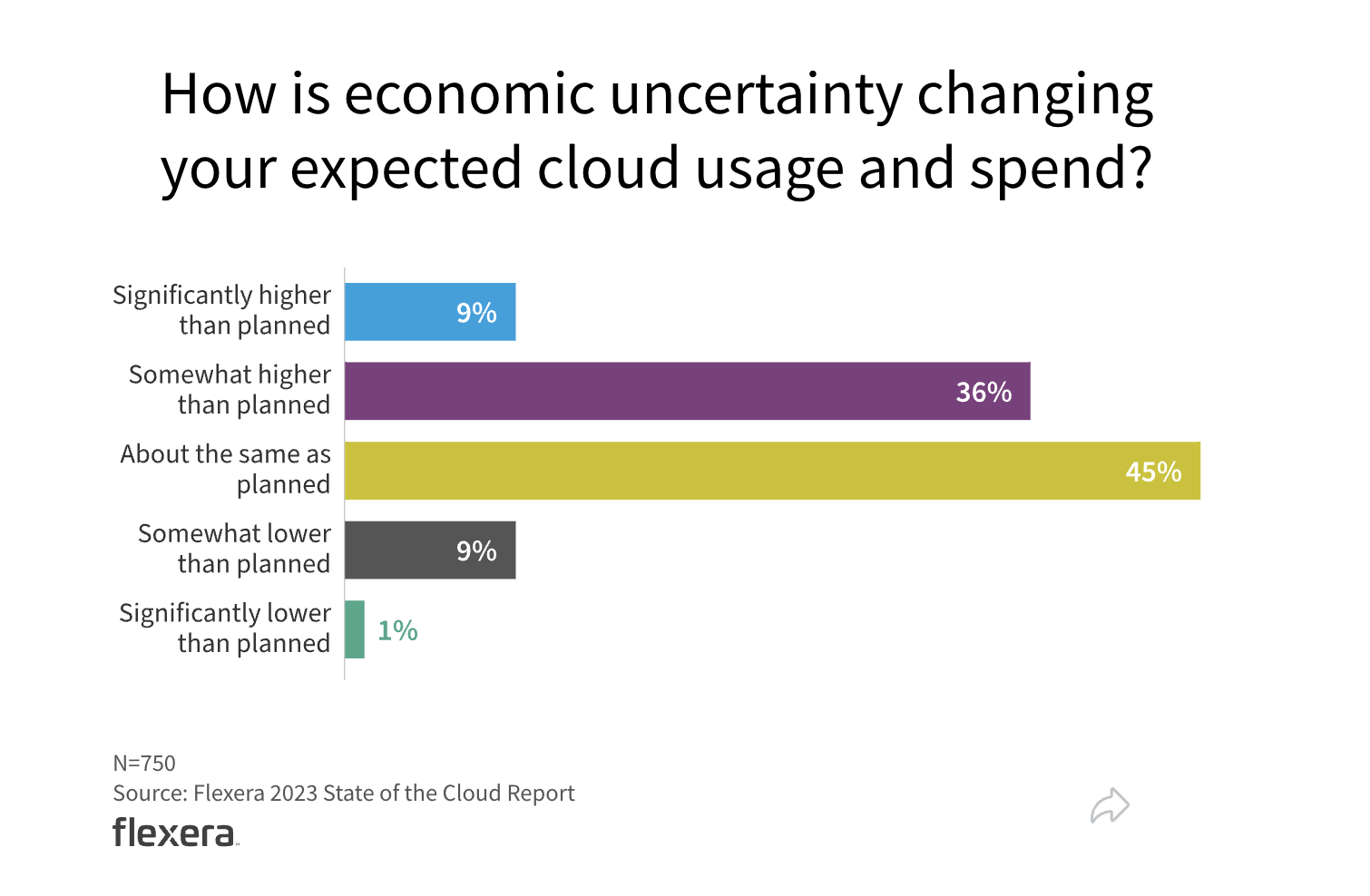
As organizations embrace the cloud, the pay-as-you-go model offers scalability; however, controlling its costs goes beyond mere management. In this regard, the FinOps framework serves as a beacon for financial and operational brilliance.
In this article, we’ll discover what FinOps is, explore its key benefits and principles, and delve into practical FinOps strategies tailored for cloud giants – AWS, Azure, and GCP.
Cloud FinOps is a modern approach that reshapes how technology, finance, and business collaborate. It goes beyond operational strategies; it’s a cultural shift aimed at fostering financial responsibility and accelerating the realization of business value during the shift to cloud computing.
In practical terms, Cloud FinOps serves as a guide for enterprises, helping them take charge of their finances, especially in the dynamic landscape of technology. By adopting Cloud FinOps, businesses can better understand the complexities linked to managing finances in the world of IT.
Additionally, it provides a structured method for recognizing the essential elements and success metrics required to achieve tangible business value.
According to Flexera, a third of cloud budgets goes to waste.

Notably, research outcomes for the year 2022 revealed a concerning trend: companies, on average, exceed their budget for cloud services by 13%. Survey participants further acknowledged a self-reported wastage of approximately 32% of their allocated cloud budget, while believing only 68% of their expenditures are used efficiently.
There’s a common misconception surrounding FinOps, with many assuming its sole focus is on reducing cloud spending, as suggested by CloudZero. However, this is just one facet of its multiple benefits.
FinOps proves invaluable in the following ways:
In the face of increasingly complex and costly cloud computing infrastructure, FinOps provides a comprehensive framework for visualizing, managing, and optimizing cloud costs.
By diving into the intricacies of cloud spend, FinOps enhances cost visibility. This includes activities such as measuring unit costs, allocating shared costs, and capturing expenses associated with untagged resources.
FinOps highlights the importance of financial accountability in the cloud, aligning the interests of finance and engineering. This alignment ensures the extraction of maximum business value from cloud investments.
Through the tracking of FinOps Key Performance Indicators (KPIs), a holistic approach is taken to optimize cloud resource usage. This involves bringing together people, processes, products, and platforms to promote efficiency.
FinOps empowers organizations to make informed decisions regarding their cloud investments by providing essential data and insights.
Beyond just cost optimization, FinOps allows organizations to allocate resources to other critical business areas, fostering overall business growth.
Embracing the design principles of cloud FinOps establishes a culture of self-governance and financial responsibility, driving both agility and accountability in the cloud.
The key building blocks are listed below.
This pillar emphasizes building lean and centralized cross-functional teams comprising engineering, architecture, finance, operations, and application owners. These teams establish governance and set standards for efficiently managing cloud spending.
Focused on developing business-value metrics and key performance indicators (KPIs), this pillar measures the success of the transformation. It often starts with cost-optimization metrics and gradually shifts to unit economics and business value metrics, such as cost per transaction or cost per customer served.
This pillar focuses on identifying key cost-optimization drivers. It is an ongoing, iterative process that provides a consistent methodology for managing cloud consumption in the most cost-effective manner. The optimization spans three critical areas: resource optimization, pricing optimization, and architecture optimization.
Effective planning and forecasting in the cloud demand a thorough understanding of cost drivers, spend allocation, and efficiency benchmarking. This pillar ensures organizations are well-equipped to navigate the complexities of cloud expenditure.
Tools and Accelerators: Bringing everything together, leveraging the right tools and accelerators is crucial for effectively managing and tracking cloud spending. This includes deploying Google Cloud cost-management tools for real-time billing and cost data analysis, developing reporting dashboards for spend and value tracking, and implementing automation scripts to establish account guardrails and receive budget alerts. These tools serve as indispensable aids in maintaining a proactive and optimized cloud financial strategy.
Each major cloud provider, be it Amazon Web Services (AWS), Microsoft Azure, or Google Cloud Platform (GCP), brings its unique suite of services, pricing models, and management tools to the table.
It’s crucial to recognize that the implementation of FinOps is far from a one-size-fits-all approach; rather, it demands meticulous customization to align with the complexities of each provider.
Let’s observe how FinOps principles are tailored for efficiency on three leading cloud platforms.
AWS stands out with a comprehensive set of tools and services tailored for FinOps specialists.
Services like AWS Cost Explorer, AWS Budgets, and AWS Trusted Advisor help organizations to delve into spending insights, set budget thresholds, and receive tailored recommendations for cost optimization.
Below we will observe each tool in more detail.
AWS Cost Explorer is a comprehensive tool designed to help users visualize, understand, and manage their AWS costs and usage.
Key features:
Cost and usage analysis
Users can explore their AWS spending data through various dimensions, such as services, linked accounts, or tags, to identify trends and patterns.
Forecasting
Cost Explorer enables users to create forecasts based on their historical usage, helping them plan and budget effectively.
Filtering and grouping
Users can filter and group cost data to gain insights into specific aspects of their AWS spending, making it easier to allocate resources efficiently.
Custom reports
The tool allows users to create customized reports for in-depth analysis tailored to their specific needs.
AWS Budgets is a service that helps users set custom cost and usage budgets that alert them when they exceed predefined thresholds. It provides proactive notifications to prevent unexpected spikes in spending.
Key features:
Budget creation
Users can define budgets based on cost, usage, or reserved instance utilization, tailoring them to specific accounts, services, or cost dimensions.
Alerts and notifications
AWS Budgets sends alerts when actual or forecasted costs breach set thresholds, allowing users to take timely actions to control spending.
Budget tracking
Users can monitor their progress toward budgeted amounts and adjust their strategies accordingly.
AWS Trusted Advisor is a cloud service that provides recommendations for improving security, optimizing performance, and reducing costs based on AWS best practices.
Key features:
Cost optimization recommendations
Trusted Advisor offers insights into cost-saving opportunities, identifying idle resources, recommending reserved instance purchases, and suggesting ways to improve resource utilization.
Security checks
It assesses security configurations and provides recommendations to enhance the security posture of AWS environments.
Performance improvement
Trusted Advisor identifies performance bottlenecks and offers suggestions to optimize resource configurations for better efficiency.
AWS further offers diverse pricing models, including On-Demand, Reserved Instances, and Spot Instances, enabling users to select the most cost-effective options based on their specific workloads.
Azure Cost Management and Azure Advisor are the core tools within the Microsoft Azure FinOps tools. These tools provide comprehensive cost tracking, budgeting features, and recommendations for optimizing resources.
Special features like Hybrid Benefit and Reserved Instances offer substantial cost savings, particularly for customers with Windows Server licenses or specific software subscriptions.
Azure Cost Management is a robust tool provided by Microsoft Azure to help organizations monitor, manage, and optimize their cloud spending. It provides insights into resource usage, cost trends, and budget adherence.
Key features:
Cost analysis
Azure Cost Management allows users to analyze their spending patterns across various dimensions, such as services, resource groups, and tags, offering a detailed breakdown of costs.
Budgeting and forecasting
Users can set budgets and forecasts to track and control spending, with proactive alerts when predefined thresholds are exceeded.
Recommendations
The tool provides cost-saving recommendations, such as resizing or shutting down underutilized resources, to optimize cloud expenses.
Azure Advisor is a service that provides personalized best practices and recommendations to optimize Azure resources for performance, security, reliability, and cost efficiency. It leverages Azure Resource Manager (ARM) data to generate actionable insights.
Key features:
Cost efficiency recommendations
Azure Advisor offers guidance on optimizing costs by identifying opportunities for resizing or purchasing reserved instances, helping users make informed decisions.
Performance recommendations
It provides insights into improving resource performance by suggesting configuration changes and enhancements.
Security and reliability best practices
Azure Advisor evaluates security configurations and reliability practices, providing recommendations to enhance the overall health and security of Azure environments.
GCP’s FinOps tools, including BigQuery for cost analysis, Budgets API for budget management, and Committed Use Discounts for savings, present a unique set of options. GCP’s sustained use discounts and preemptible instances offer flexibility in pricing.
Understand billing and cost management
Use GCP’s free billing tools for a clear understanding and organization of costs.
Optimize compute resources
Identify and deactivate idle VMs and disks, automate VM start/stop schedules, rightsize VMs based on workload changes, and leverage affordable preemptible VMs for fault-tolerant workloads.
Optimize cloud storage
Assess storage classes based on data access frequency, use lifecycle policies for automated adjustments, and minimize duplicate data through proper configuration.
Tune data warehouse costs
Enforce controls with maximum bytes billed settings, utilize partitioning and clustering for cost-effective queries, evaluate the need for real-time data, and consider Flex Slots for predictable costs in high-volume scenarios.
Filter network traffic
Identify top spending services using Cloud Platform SKUs, choose a network service tier based on performance needs, and optimize cloud logging by filtering unnecessary logs and enabling sampling.
Achieving cloud cost efficiency across AWS, Azure, and GCP requires a holistic FinOps approach.
By prioritizing cost visibility, implementing automated scaling, leveraging reserved capacity and discounts, and maintaining continuous monitoring, organizations can strike a balance between innovation and cost control in the cloud environment.
Kanda Software has decades of experience helping companies manage their finances better in the cloud. Whether you’re already using the cloud, or planning to create a new online application, Kanda’s expertise in various types of cloud setups will help your business build powerful, safe, and flexible FinOps practices.
Are you ready to embark on your FinOps journey? Talk to us today.



